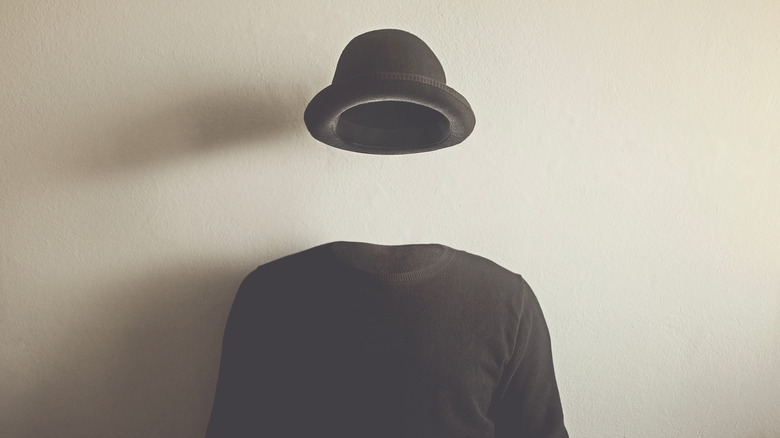The Science Behind The Rare Condition Known As Walking Corpse Syndrome
In a 2013 interview with New Scientist, a man named Graham described the sensation of his brain dying. We've all been lagging on a Friday afternoon or so exhausted after a long day that we lose the ability to think straight. But Graham felt as if his life had lost all its meaning, could hardly speak, and also strangely lost his sense of smell and taste. His body was alive, but he felt as if he were dead. Without anything as small as a cigarette being able to give him pleasure in his daily life, he even started to visit the local graveyard, where he felt more comfortable among the dead.
At the neurologist's office, doctors discovered a large part of Graham's brain was actually in a vegetative state as if he were under anesthesia or sleeping. The case study is not the only one describing this phenomenon, officially called walking corpse syndrome, or Cotard's syndrome.
Patient zero: Mademoiselle X
According to Scientific American, the first person to be diagnosed with Cotard's syndrome was a Parisian who went by the name of Mademoiselle X in the scientific literature for confidentiality purposes (like the English "Jane Doe"). Many mental health conditions we are familiar with these days, like depression, can leave patients with feelings of despair or self-loathing. But what this Mademoiselle X patient presented with in 1880 was a deep belief that her body did not exist. She was convinced she was going to hell, yet could not die. Instead, she was doomed to exist in this world, with no appetite for the living world. In fact, she actually later died from starvation.
Jules Cotard, the French psychiatrist on the case, was a great mind in consciousness research at the time. Due to his work with Mademoiselle X, the diagnosis was officially described in his namesake (via Neurology).
If you or someone you know is struggling with mental health, please contact the Crisis Text Line by texting HOME to 741741, call the National Alliance on Mental Illness helpline at 1-800-950-NAMI (6264), or visit the National Institute of Mental Health website.
The brain science
Cotard's syndrome results when lesions form in certain areas of the brain that cloud a patient's perception. Specifically, the areas of the brain that recognize faces and process emotions are effectively shut off, leading them to experience extreme apathy and nihilism, per Scientific American. Sometimes walking corpse syndrome can arise as a symptom of severe depression and is often characterized as a form of delusion or psychosis, per Health.com.
In many cases, the delusion that the patient is a walking corpse stems from a real place. That is, Graham, in the New Scientist article, experienced the onset of Cotard's syndrome after attempting suicide. One of the earlier cases recorded involved a man who crashed his motorcycle in a near-fatal accident. In another case, a man was convinced he was dead because he kept feeling someone stabbing his chest wall, and he actually had a tumor in the same spot that was causing him pain.
If you or anyone you know is having suicidal thoughts, please call the National Suicide Prevention Lifeline at 1-800-273-TALK (8255).
Environmental triggers
Although this condition has been around for close to two centuries, scientists are still learning more about it. In 2013, researchers discovered that a drug used commonly to treat cold sores was associated with the onset of Cotard's syndrome, though it was a small correlation (via New Scientist). Using a large sample of hospital data, they found eight patients on the drug had started developing walking corpse syndrome, including one woman who ran into the hospital hysterical, convinced that her limbs were not hers and that she was a walking corpse.
However, the good news for these patients on the cold sore drug was that they no longer felt like corpses and regained the feeling of their bodies after they stopped using it. Researchers believe that what distinguishes people from developing this has roots in genetics and may be triggered by external factors like a drug (per Health.com).
The patient population
The average age of people with Cotard's syndrome is 50, but there have also been cases among teenagers, according to Healthline. Generally, it's more common among people with other mental health disorders like bipolar depression and depression. In a review of the condition published in 2011 in the journal Neuropsychiatry, close to 90% of cases were among people with depression. Still, walking corpse syndrome is very rare — according to WebMD, there are approximately 200 cases reported worldwide.
The occurrence of Cotard's syndrome is actually decreasing over time, likely because many people with psychosis or depression in the 19th century were labeled as having Cotard's syndrome when in fact, they had one of the mental health conditions we are more familiar with today (via the Journal of Neurosciences in Rural Practices). It's also more common among people with other neurological conditions like migraines, dementia, and epilepsy, per Health.com.
Finding treatment
According to Scientific American, Cotard's syndrome is not the easiest disorder to treat. However, doctors can use antidepressants and antipsychotic medications to reduce psychotic episodes and delusions associated with walking corpse syndrome.
Although this disorder is unusual, and it's a bit otherworldly to imagine someone truly believing they are dead, these patients have a high risk of mental health problems and self-harm. In one case study in 2021, one patient developed Cotard's delusion after recovering from COVID-19 (via Early Intervention in Psychiatry). So-called "long COVID" is a persistent condition following a COVID-19 infection that may result in fatigue, "brain fog," and a continued loss of smell or taste, according to BBC News. Like Cotard's syndrome, there is still a lot unknown about long COVID. But in a way, it makes sense that the two could be connected, not only with physical symptoms like the loss of taste and smell but also with the mysterious cloudiness of the brain that prevents a person from fully experiencing life as we know it — a persistent sense of being brain dead.





